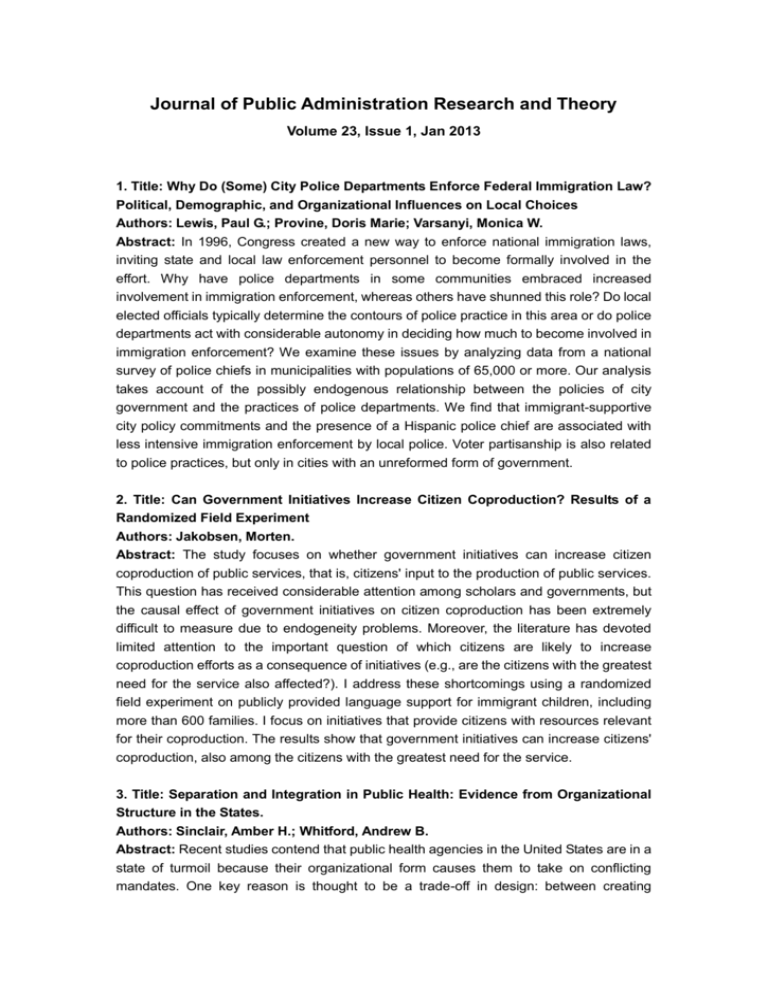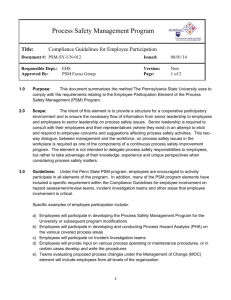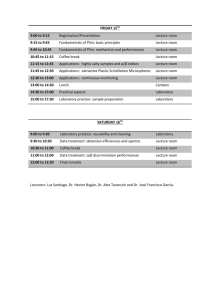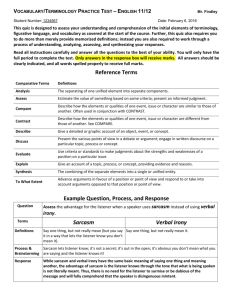Journal of Public Administration Research and Theory Volume 23
advertisement

Journal of Public Administration Research and Theory Volume 23, Issue 1, Jan 2013 1. Title: Why Do (Some) City Police Departments Enforce Federal Immigration Law? Political, Demographic, and Organizational Influences on Local Choices Authors: Lewis, Paul G.; Provine, Doris Marie; Varsanyi, Monica W. Abstract: In 1996, Congress created a new way to enforce national immigration laws, inviting state and local law enforcement personnel to become formally involved in the effort. Why have police departments in some communities embraced increased involvement in immigration enforcement, whereas others have shunned this role? Do local elected officials typically determine the contours of police practice in this area or do police departments act with considerable autonomy in deciding how much to become involved in immigration enforcement? We examine these issues by analyzing data from a national survey of police chiefs in municipalities with populations of 65,000 or more. Our analysis takes account of the possibly endogenous relationship between the policies of city government and the practices of police departments. We find that immigrant-supportive city policy commitments and the presence of a Hispanic police chief are associated with less intensive immigration enforcement by local police. Voter partisanship is also related to police practices, but only in cities with an unreformed form of government. 2. Title: Can Government Initiatives Increase Citizen Coproduction? Results of a Randomized Field Experiment Authors: Jakobsen, Morten. Abstract: The study focuses on whether government initiatives can increase citizen coproduction of public services, that is, citizens' input to the production of public services. This question has received considerable attention among scholars and governments, but the causal effect of government initiatives on citizen coproduction has been extremely difficult to measure due to endogeneity problems. Moreover, the literature has devoted limited attention to the important question of which citizens are likely to increase coproduction efforts as a consequence of initiatives (e.g., are the citizens with the greatest need for the service also affected?). I address these shortcomings using a randomized field experiment on publicly provided language support for immigrant children, including more than 600 families. I focus on initiatives that provide citizens with resources relevant for their coproduction. The results show that government initiatives can increase citizens' coproduction, also among the citizens with the greatest need for the service. 3. Title: Separation and Integration in Public Health: Evidence from Organizational Structure in the States. Authors: Sinclair, Amber H.; Whitford, Andrew B. Abstract: Recent studies contend that public health agencies in the United States are in a state of turmoil because their organizational form causes them to take on conflicting mandates. One key reason is thought to be a trade-off in design: between creating stand-alone agencies for health and environment and creating agencies that combine the two. We use data on the organizational form of state health and environmental agencies to assess the choice of organizational form as a problem of institutional design from the perspective of path-dependency theory. Our results suggest that initial social conditions help explain the choice of combined or independent agencies. We believe that this case provides useful information about the roots of organizational design for resolving competing demands and provides insight into concerns about the delivery of health and environmental protection in the states. 4. Title: Investigating the Structure and Meaning of Public Service Motivation across Populations: Developing an International Instrument and Addressing Issues of Measurement Invariance. Authors: Kim, Sangmook; Vandenabeele, Wouter; Wright, Bradley E.; Andersen, Lotte Bøgh; Cerase, Francesco Paolo; Christensen, Robert K.; Desmarais, Céline; Koumenta, Maria; Leisink, Peter; Bangcheng Liu; Palidauskaite, Jolanta; Pedersen, Lene Holm; Perry, James L.; Ritz, Adrian; Taylor, Jeannette; De Vivo, Paola. Abstract: The growth in international research on public service motivation (PSM) raises a number of important questions about the degree to which the theory and research developed in one country can contribute to our understanding of PSM in other counties. To help address this issue, this study revisits the conceptual and operational definitions of PSM to address weaknesses previously noted in the literature. Although some important steps have been taken to both improve and internationalize the PSM scale, this work has been done incrementally. In contrast, this study takes a more systematic and comprehensive approach by combining the efforts of international PSM scholars to develop and then test a revised measurement instrument for PSM in 12 countries. Although the resulting four dimensional 16-item measure of PSM reported here provides a better theoretical and empirical foundation for the measurement of PSM, our results suggest that the exact meaning and scaling of PSM dimensions are likely to differ across cultures and languages. These results raise serious concerns regarding the ability to develop a single universal scale of PSM, or making direct comparisons of PSM across countries. 5. Title: Institutional Logic and Street-Level Discretion: The Case of HIV Test Counseling. Authors: Garrow, Eve E.; Grusky, Oscar. Abstract: Research on variation in policy implementation has examined how individualand organizational-level variables shape discretionary practices at the frontlines of implementation but has given less attention to the influence of the organizational field. From an institutional logics perspective the practices of street-level workers are likely to be more congruent with policy intent when policy is consistent with the core institutional logic that structures the organizational field. Using data from a probability sample of 90 Los Angeles County HIV/AIDS health organizations and 216 frontline practitioners, our findings suggest that the extent to which implementation of HIV test counseling follows guidelines of the Centers for Disease Control and Prevention (CDC) is related to consistency between CDC policy and core institutional logic when accounting for individual-level factors such as client need; practitioners' professional orientation, knowledge, experience, and training; and organizational constraints such as workload pressures and formalization. 6. Title: Awareness of Evidence-Based Practices by Organizations in a Publicly Funded Smoking Cessation Network. Authors: Provan, Keith G.; Beagles, Jonathan E.; Mercken, Liesbeth; Leischow, Scott J. Abstract: This research examines the awareness of evidence-based practices by the public organizations that fund services in the North American Quitline Consortium (NAQC). NAQC is a large, publicly funded, goal-directed "whole network," spanning both Canada and the United States, working to get people to quit smoking. Building on prior research on the dissemination and diffusion of innovation and evidence-based practices, and considering differences between network ties that are homophilous versus instrumental, we found that awareness of evidence-based practices was highest for quitline funders that were strongly connected directly to researchers and indirectly to the network administrative organization, controlling for quitline spending per capita and decision-making locus of control. The findings support the importance of maintaining instrumental (a technical/rational argument) rather than homophilous ties for acquisition of evidence-based practice knowledge. The findings also offer ideas for how public networks might be designed and governed to enhance the likelihood that the organizations in the network are better aware of what evidence-based practices exist. 7. Title: Using Employee Empowerment to Encourage Innovative Behavior in the Public Sector Authors: Fernandez, Sergio; Moldogaziev, Tima. Abstract: Employee empowerment programs have been widely adopted in the public sector as a way to improve organizational performance. Empowered employees improve performance largely by finding innovative ways of correcting errors in service delivery and redesigning work processes. Failure to encourage innovation can seriously undermine the effectiveness of empowerment programs. Based on Bowen and Lawler's conceptualization of employee empowerment as a multifaceted management approach, this study explores how different empowerment practices can be used to encourage US federal government employees to seek out new and better ways of doing things. The empirical results show that while employee empowerment as an overall approach can increase encouragement to innovate, empowerment practices have divergent effects, and some may even discourage innovation. 8. Title: Nonprofit Sector Growth and Density: Testing Theories of Government Support. Authors: Lecy, Jesse D.; Van Slyke, David M. Abstract: Theories of nonprofit density have assumed a variety of dispositions toward the state, including opposition, suspicion, indifference, and mutual dependence. In this article, we conduct the first large-scale simultaneous empirical test of the two most prominent nonprofit theories: government failure theory and interdependence theory. The former characterizes nonprofit activities as substitute or oppositional to state programs, accounting for the limitations and failures of government-provided services and more reflective of the heterogeneity of demand for services. The latter emphasizes the more complementary and collaborative nature of nonprofit activities, focusing on the overlapping agendas of nonprofits and the state and the mutual dependency that arises from partnership. The theories are difficult to test empirically because both predict the same relationship between state capacity and the size of the nonprofit sector, albeit for theoretically distinct reasons. A true joint test requires the separation of government support from private support for nonprofits. Using a newly constructed panel dataset in which we separate out nonprofit revenue sources normally agglomerated in the Internal Revenue Service 990 data, we examine the empirical merits of both theories to answer the question of whether human service nonprofit organizations thrive when government fails or when government collaborates. Our findings suggest that government funding has a more favorable effect on nonprofit density than private donations. The findings raise several policy and management implications that need evaluation. 以下是书评: 9. Title: Collaboration Is the Name of the Game: Information, Innovation, and Mitigation. Authors: Smith, Amy E. Abstract: The article reviews the books "How Information Matters: Networks and Public Policy Innovation," by Kathleen Hale, "Implementing Innovation: Fostering Enduring Change in Environmental and Natural Resource Governance," by Toddi A. Steelman, and "Self-Organizing Federalism: Collaborative Mechanisms to Mitigate Institutional Collective Action Dilemmas," edited by Richard C. Feiock and John T. Scholz.







